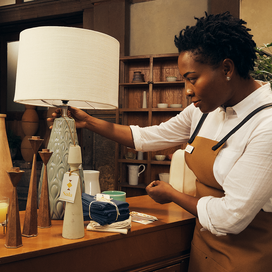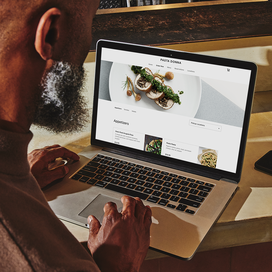Table of contents
Pop-up shops are no longer just a trend: The pop-up industry generates an estimated $80 billion in annual revenue, and brands ranging from Nordstrom to Sprite are hosting pop-ups of their own to create a new kind of customer experience.
These in-person, customer-driven events can help a business take its marketing and sales tactics to the next level, no matter how big or small. Here’s what to know about pop-ups, the different forms they come in, and how to open a pop-up shop yourself.
What is a pop-up shop?
A pop-up shop (sometimes referred to as a pop-up store or flash retailing) is a temporary storefront that’s intended to attract a high volume of customers over a short period of time. These physical locations can range from brick-and-mortar spaces to market stalls, and because they aren’t meant to be permanent, they work well for generating brand awareness or introducing new products.
What are the benefits of a pop-up shop?
Pop-up shops offer unique advantages for businesses of all sizes, such as:
- Allowing face-to-face engagement, which can help build brand awareness and brand loyalty.
- Launching and testing the traction of new products, often at a lower cost than opening a permanent physical store.
- Generating excitement around a business or brand through strategic marketing.
- Reaching and connecting with customers at the community level, which can be especially useful for online-only or new businesses.
- Providing an intimate in-person customer experience that can help highlight a brand’s values.
Types of pop-up shops
Pop-up shops come in many varieties, each serving different business goals. Here are some of the most common formats:
Seasonal or holiday pop-ups
These pop-ups are tailored to major shopping seasons or holidays, such as Halloween, Christmas, or Valentine’s Day. They attract customers looking for timely gifts, limited-edition products, or festive experiences. Examples include holiday decor stores, gift boutiques, or specialty food stalls.
Themed pop-ups
A themed pop-up revolves around a central idea or trend — think wellness, nostalgia, or sustainability. Themed shops can help introduce new product lines or highlight collaborations and partnerships. They often feature unique decor, exclusive merchandise, and interactive elements.
Sampling pop-ups
Sampling pop-ups are designed to let customers try before they buy. Whether you’re in the food and beverage industry or retail, offering samples can build trust and encourage sales. These events are ideal for launching new menu items or showcasing product innovations.
Interactive pop-ups
Interactive pop-ups go beyond traditional displays by offering hands-on experiences, such as live demonstrations, workshops, or immersive installations. These shops create memorable moments and often generate strong social media buzz.
Promotional or marketing pop-ups
Promotional pop-ups support product launches, special discounts, or brand campaigns. They’re often used to build anticipation for new releases or to drive traffic during key sales periods. These pop-ups can include giveaways, influencer partnerships, or exclusive previews.
In-store pop-ups
An in-store pop-up is a shop-within-a-shop, typically a temporary installation inside an existing store or venue. This format enables businesses to tap into established foot traffic and collaborate with complementary brands for mutual benefit.
How to start a pop-up shop: checklist
If you’re going to host a pop-up shop event, here’s what you’ll need for a successful experience:
1. Decide what to sell at your pop-up shop
Pop-up shops present a unique opportunity for strategic selling. They can work well for customer interaction with products that are normally only available online or for providing a different product experience than customers are used to — like live demos, in-person introduction to products, or showcasing curated collections.
You may want to focus on a specific product or theme to sell around, or, in some cases, use the pop-up experience to test the results of launching an entirely new product.
2. Determine your goals
Your business goals can help determine what type of pop-up shop you want to host. If you’re trying to generate awareness around your brand, you may want to take a different approach to your pop-up than if you’re testing out the traction of a new item.
Your business goals can also help you decide which products to focus on. Pop-ups can be a great opportunity to increase exposure to products that customers aren’t familiar with or help move specific inventory, and can help drive customers back to your online store or business afterwards.
Some examples of goals for your pop-up could be:
- Building brand awareness in a new market
- Generating sales for a specific product line
- Collecting customer feedback
- Growing your email or loyalty program list
- Testing a potential permanent location
3. Calculate the cost of a pop-up shop
One major advantage of pop-up shops is that they’re typically less expensive than a permanent storefront. Thanks to their temporary lifespan and flexibility in location, pop-up shops tend to come with fewer financial commitments. In a pop-up shop survey conducted by Storefront, 44% of retailers surveyed reported spending less than $5,000 on their pop-up space.
Still, there are some important costs to consider (and things you’ll need) when opening a pop-up shop, including:
- Rent of a physical location or stall
- Display components and decor
- Staff
- Marketing
- Permits
- Technical setup (like payment processing)
- Insurance
Luckily, small businesses can still create pop-ups on a budget by utilizing less-expensive physical locations, DIY display and decor, free social media marketing, and cost-effective in-person payments.
4. Choose a location
Pop-up shops can come in all shapes and sizes, ranging from full brick-and-mortar storefronts to a stand-alone stall at a market or event. But no matter what form your pop-up takes, choosing its location depends on what products you’re offering, the theme of your pop-up, and who your target market is.
Factors that can help determine the best location for your pop-up shop are location cost, necessary amenities the location offers (like electricity or running water), amount of customer foot traffic, and the type of customer at the location.
Locations to consider for a pop-up include:
- A vacant shop in an area you’ve determined you want to target. You may be able to rent the space on a short-term basis.
- Space in a shopping mall with stalls or kiosks is ideal for pop-up opportunities.
- Space in a larger store or venue, like a retail outlet or an entertainment venue, that will allow a pop-up in their spare space.
- A space designed for pop-ups that offers short-term leases, specifically catered to a mix of pop-up stores.
- Your local street market, like a farmers market or craft fair, where a range of customers come to shop and browse.
- A mobile space that allows you some flexibility in location. Food trucks are a great example of mobile pop-ups, but require some additional consideration in terms of costs and permitting.
- A trade event or industry-specific event where customers have come to shop for or learn more about the product you offer.
5. Design your pop-up shop
Create an inviting, on-brand environment that stands out. Consider:
- Layout and flow to encourage browsing
- Eye-catching signage and displays
- Lighting and music to set the mood
- Interactive or Instagram-worthy features
- Accessibility for all customers
Your shop’s design should reflect your brand and make it easy for customers to shop, interact, and share their experience.
6. Advertise your pop-up shop
There’s no such thing as too much marketing for a pop-up shop. Since you’ll only be there for a short period of time, you want as many customers to know about it as possible. And if your pop-up shop has a theme or is timely or seasonal, you can use that to your advantage in your marketing efforts.
Use a mix of these strategies:
- Social media: Announce your pop-up with teaser posts and stories. Use location tags and event hashtags and collaborate with local influencers.
- Email campaigns: Notify your existing customers about your pop-up dates and location through an email or text campaign. Offer exclusive incentives for attending.
- Partner with other businesses: Team up with neighboring stores for cross-promotion. Join local events or markets to leverage their audience.
- Print materials: Distribute flyers, posters, or business cards in your area. Use QR codes to link to your website or event details.
- On-site signage and promotion: Ensure clear, eye-catching signage at your location. Provide handouts or branded merchandise for visitors.
- Online listings: Update your website and Google Business Profile with your event details.
7. Make the payment experience seamless
Once customers are at your pop-up, making it fast and easy for them to buy your products is key. Payment processing tools like a credit card reader, a point-of-sale system, and even QR code payments can help make the checkout process simple by allowing you to quickly accept card and digital payments and provide digital receipts.
Taking payments isn’t the last step, though. After you’ve gone through the work of opening a pop-up shop and getting customers in the door, keep in touch with them by directing them to your online store. Let them know about upcoming events or promotions through email marketing, or even encourage them to enroll in a loyalty program that incentivizes them to keep buying from you.
How to measure the success of your pop-up
Once your pop-up shop wraps up, measure its impact to inform future events. Key metrics to consider here include:
- Total sales and average transaction value
- Number of new customers acquired
- Growth of your email or SMS marketing list
- Social media engagement and mentions
- Customer feedback and reviews
- Changes in online store traffic post-event
Use analytics tools like Square Dashboard to track performance and guide your next steps.
Pop-up shop FAQs
What do I need to start a pop-up shop?
To start a pop-up shop, you’ll need a clear business goal, a curated selection of products, a suitable location, necessary permits, staff support, and a reliable payment system. Good marketing and engaging shop design are also essential for attracting and retaining customers.
Do I need an LLC to start a pop-up shop?
An LLC is not mandatory to start a pop-up shop, but having a legal business structure can provide liability protection. Check local regulations and consult a professional to determine the best option for your pop-up business.
Do I need a permit to start a pop-up shop?
Yes, most locations will require permits or licenses, which can vary by city and state. These may include temporary business licenses, sales tax permits, and health or fire safety permits. Always verify requirements with local authorities before opening a pop-up shop.
How profitable is a pop-up shop? How much does it cost?
Profitability depends on your location, product selection, marketing, and customer engagement. According to data from Storefront, the majority of businesses spend less than $5,000 to launch a pop-up, but costs can vary widely. When done strategically, pop-ups can deliver a strong return by generating sales, building brand awareness, and fostering customer loyalty.
![]()













